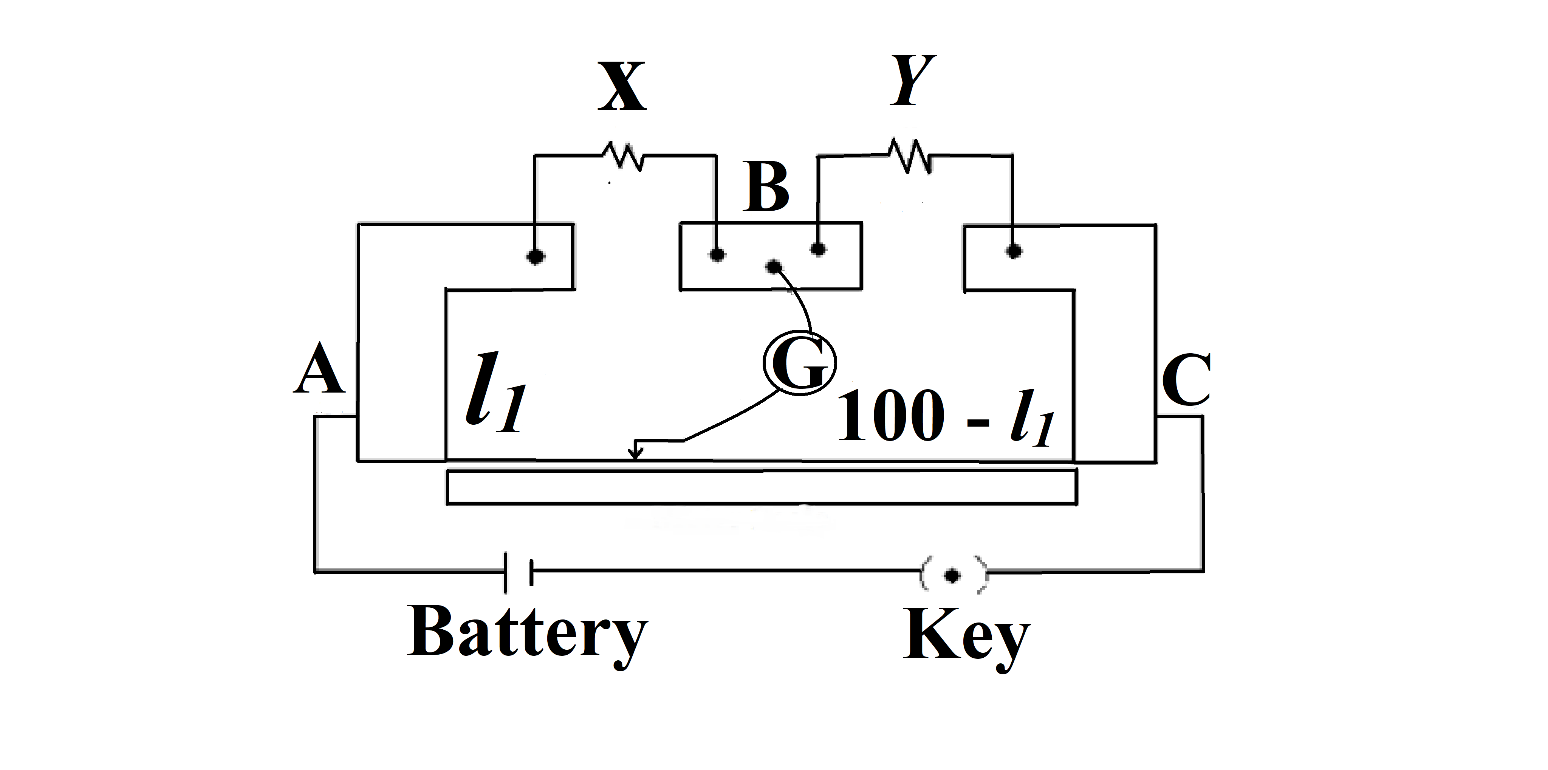
In a meter bridge, as shown in the figure, it is given that resistance \[Y=12.5\Omega \] and that balance is obtained at distance 39.5 cm, from the end A (by the jockey J). After interchanging the resistances X and Y, a new balance point is found at a distance ${{l}_{2}}$ from end A. What are the values of X and ${{l}_{2}}$?


Answer
471.9k+ views
Hint: A meter bridge, also known as a slide wire bridge, is an instrument that functions on the Wheatstone bridge principle. A meter bridge is used to describe a conductor 's uncertain resistance as that of a Wheatstone bridge, which was invented in 1843 by The Wheatstone bridge was invented by Samuel Hunter Christie. We can solve this question using the meter bridge formula.
Formula used:
For solving this question, we will be using the formula for the meter bridge, i.e.,
$X=Y\dfrac{l}{(100-l)}$
Complete answer:
Before solving the question, let us take a look at the given parameters
$X=12.5\Omega $
$l=39.5cm$
By using the values given above, we can find the value of the other resistance, i.e., Y
So,
$X=Y\dfrac{l}{(100-l)}$
$\Rightarrow 12.5=Y\times \dfrac{39.5}{(100-39.5)}$
$\Rightarrow X=12.5\times \dfrac{60.5}{39.5}$
$\Rightarrow X=8.16\Omega $
Now, we have the values of both X and Y, so moving on to the second part
The resistances are interchanged
Again, applying the same method
We have,
$Y=X\dfrac{{{l}_{2}}}{(100-{{l}_{2}})}$
$\Rightarrow \dfrac{12.5}{8.16}=\dfrac{{{l}_{2}}}{(100-{{l}_{2}})}$
$\Rightarrow 1.53(100-{{l}_{2}})={{l}_{2}}$
$\Rightarrow \dfrac{153}{2.53}={{l}_{2}}$
$\Rightarrow {{l}_{2}}=60.5cm$
So after solving, we have the values
$X=8.16\Omega $
${{l}_{2}}=60.5cm$
Note:
The reason why we subtract the length of the balance point by 100 is because the meter bridge is 100 cm long (or 1 m long as the name suggests itself). The meter bridge works on the theory that the ratio of resistances is equal to the ratio of their corresponding lengths, i.e., distance of the balance point from their respective sides.
Formula used:
For solving this question, we will be using the formula for the meter bridge, i.e.,
$X=Y\dfrac{l}{(100-l)}$
Complete answer:
Before solving the question, let us take a look at the given parameters
$X=12.5\Omega $
$l=39.5cm$
By using the values given above, we can find the value of the other resistance, i.e., Y
So,
$X=Y\dfrac{l}{(100-l)}$
$\Rightarrow 12.5=Y\times \dfrac{39.5}{(100-39.5)}$
$\Rightarrow X=12.5\times \dfrac{60.5}{39.5}$
$\Rightarrow X=8.16\Omega $
Now, we have the values of both X and Y, so moving on to the second part
The resistances are interchanged
Again, applying the same method
We have,
$Y=X\dfrac{{{l}_{2}}}{(100-{{l}_{2}})}$
$\Rightarrow \dfrac{12.5}{8.16}=\dfrac{{{l}_{2}}}{(100-{{l}_{2}})}$
$\Rightarrow 1.53(100-{{l}_{2}})={{l}_{2}}$
$\Rightarrow \dfrac{153}{2.53}={{l}_{2}}$
$\Rightarrow {{l}_{2}}=60.5cm$
So after solving, we have the values
$X=8.16\Omega $
${{l}_{2}}=60.5cm$
Note:
The reason why we subtract the length of the balance point by 100 is because the meter bridge is 100 cm long (or 1 m long as the name suggests itself). The meter bridge works on the theory that the ratio of resistances is equal to the ratio of their corresponding lengths, i.e., distance of the balance point from their respective sides.
Recently Updated Pages
What percentage of the area in India is covered by class 10 social science CBSE

The area of a 6m wide road outside a garden in all class 10 maths CBSE

What is the electric flux through a cube of side 1 class 10 physics CBSE

If one root of x2 x k 0 maybe the square of the other class 10 maths CBSE

The radius and height of a cylinder are in the ratio class 10 maths CBSE

An almirah is sold for 5400 Rs after allowing a discount class 10 maths CBSE

Trending doubts
The Equation xxx + 2 is Satisfied when x is Equal to Class 10 Maths

Why is there a time difference of about 5 hours between class 10 social science CBSE

Change the following sentences into negative and interrogative class 10 english CBSE

What constitutes the central nervous system How are class 10 biology CBSE

Write a letter to the principal requesting him to grant class 10 english CBSE

Explain the Treaty of Vienna of 1815 class 10 social science CBSE




